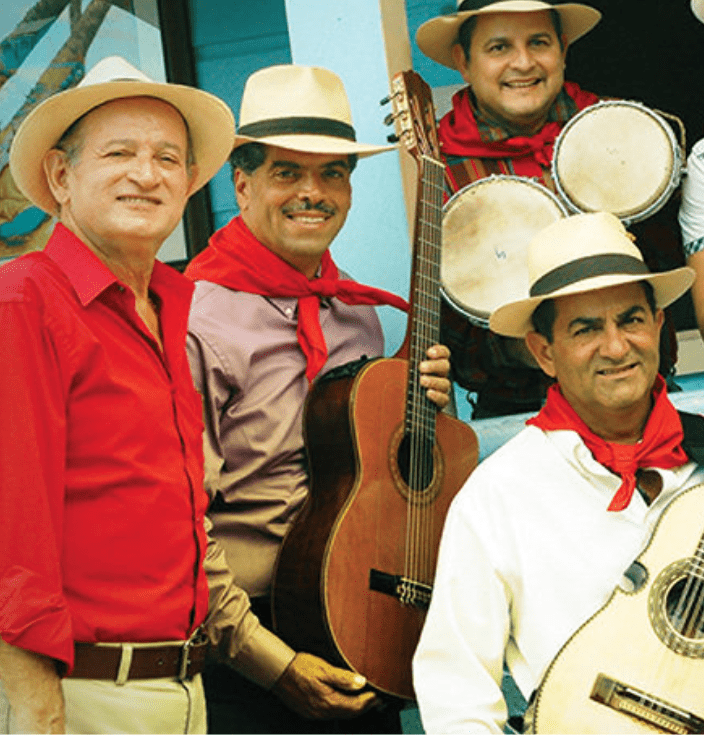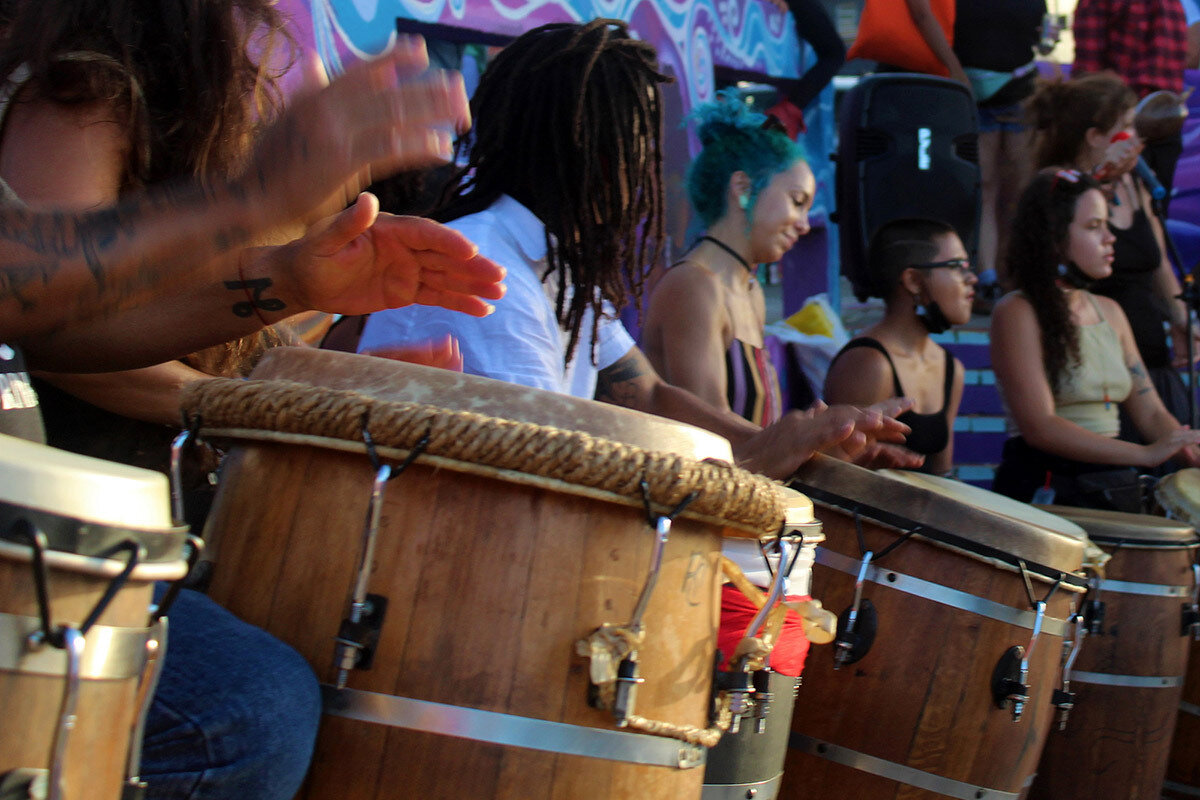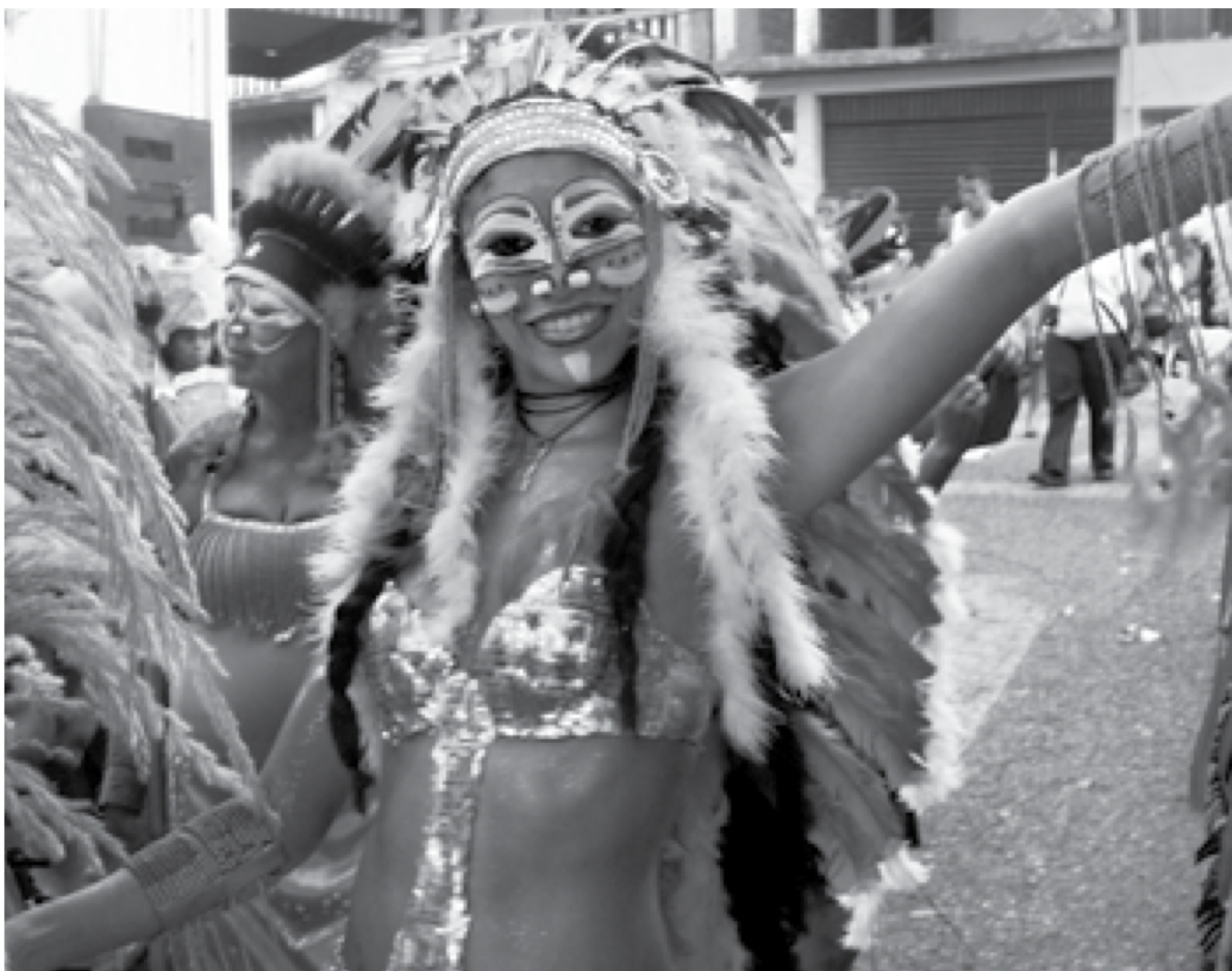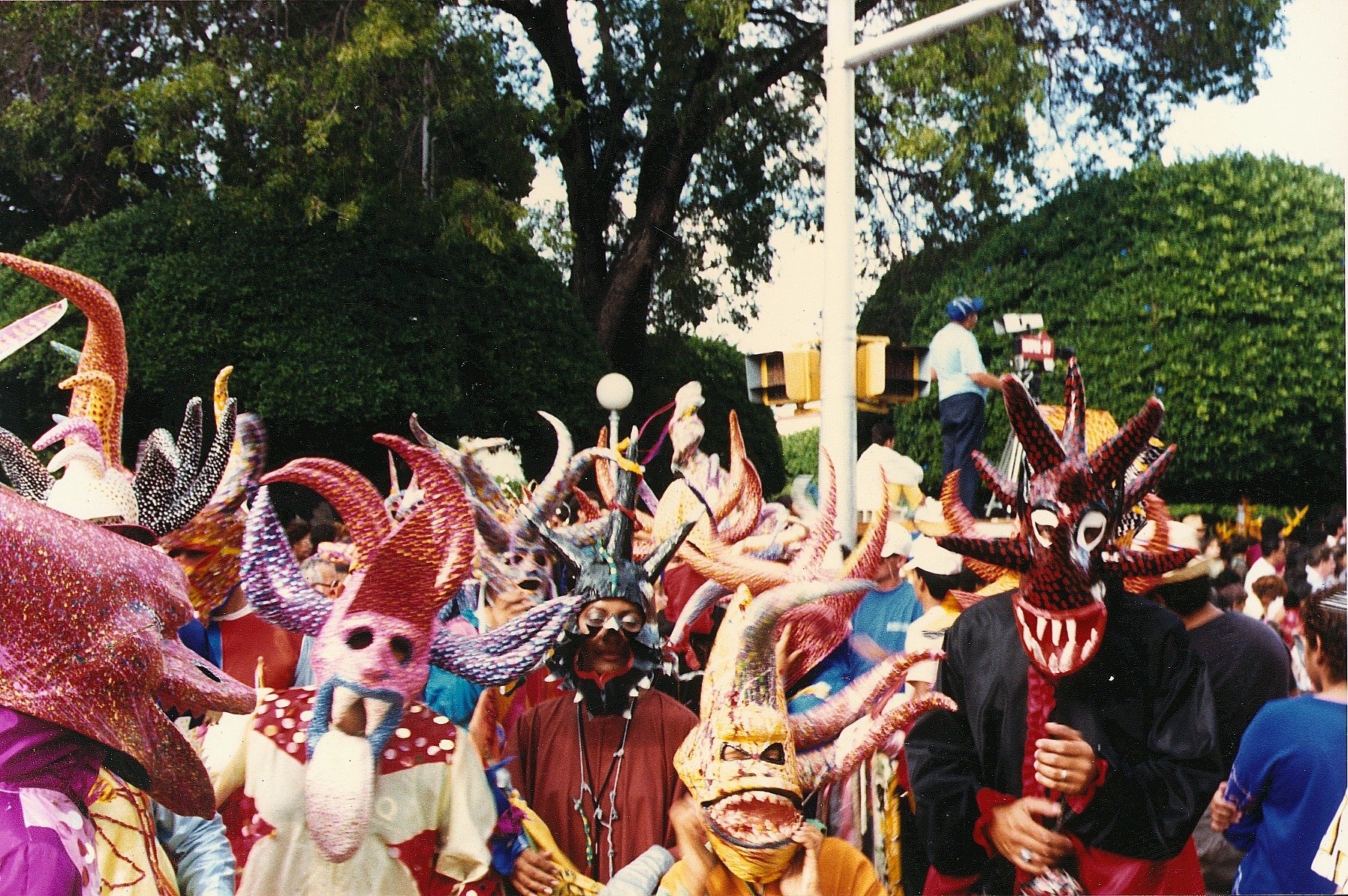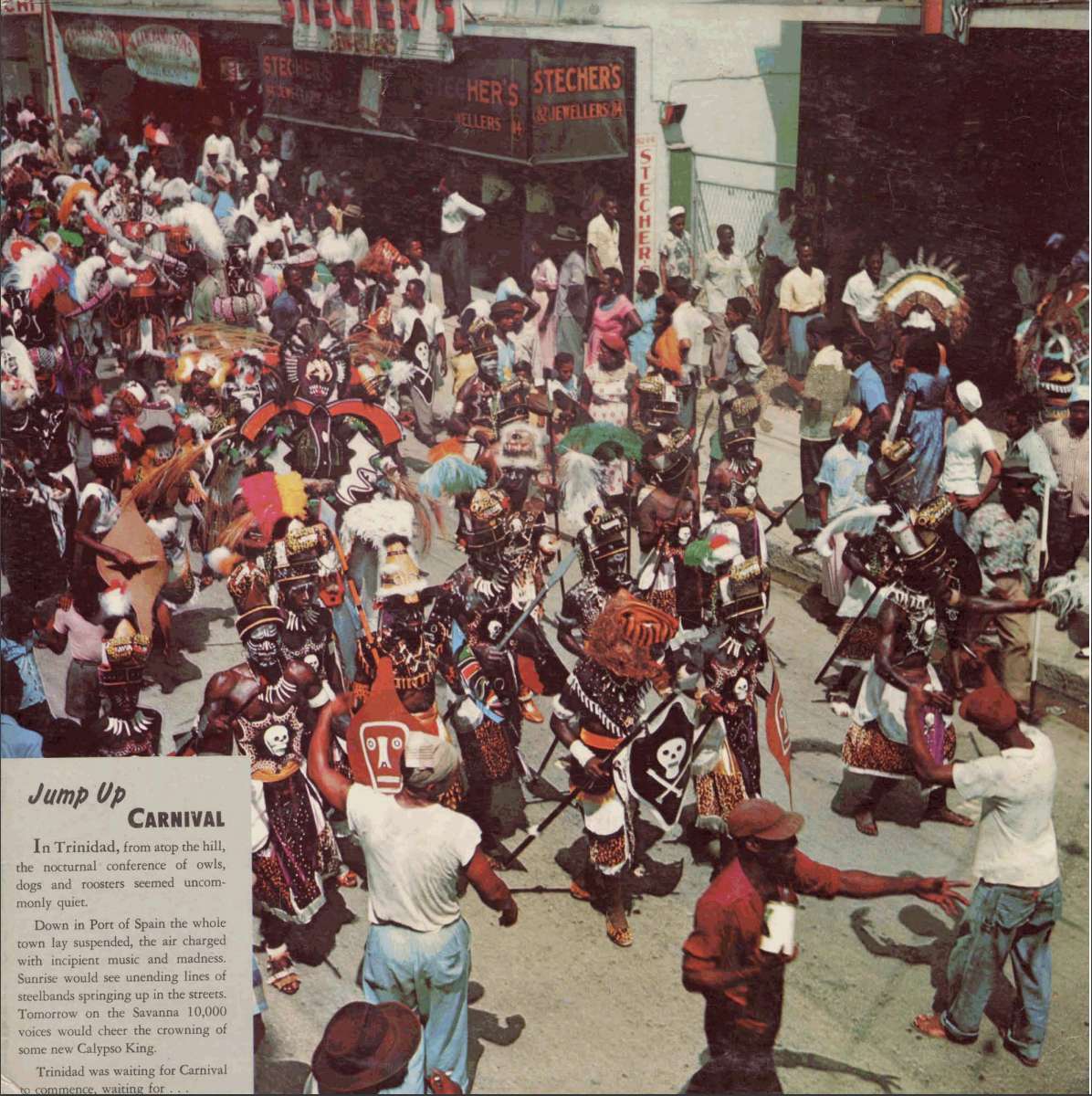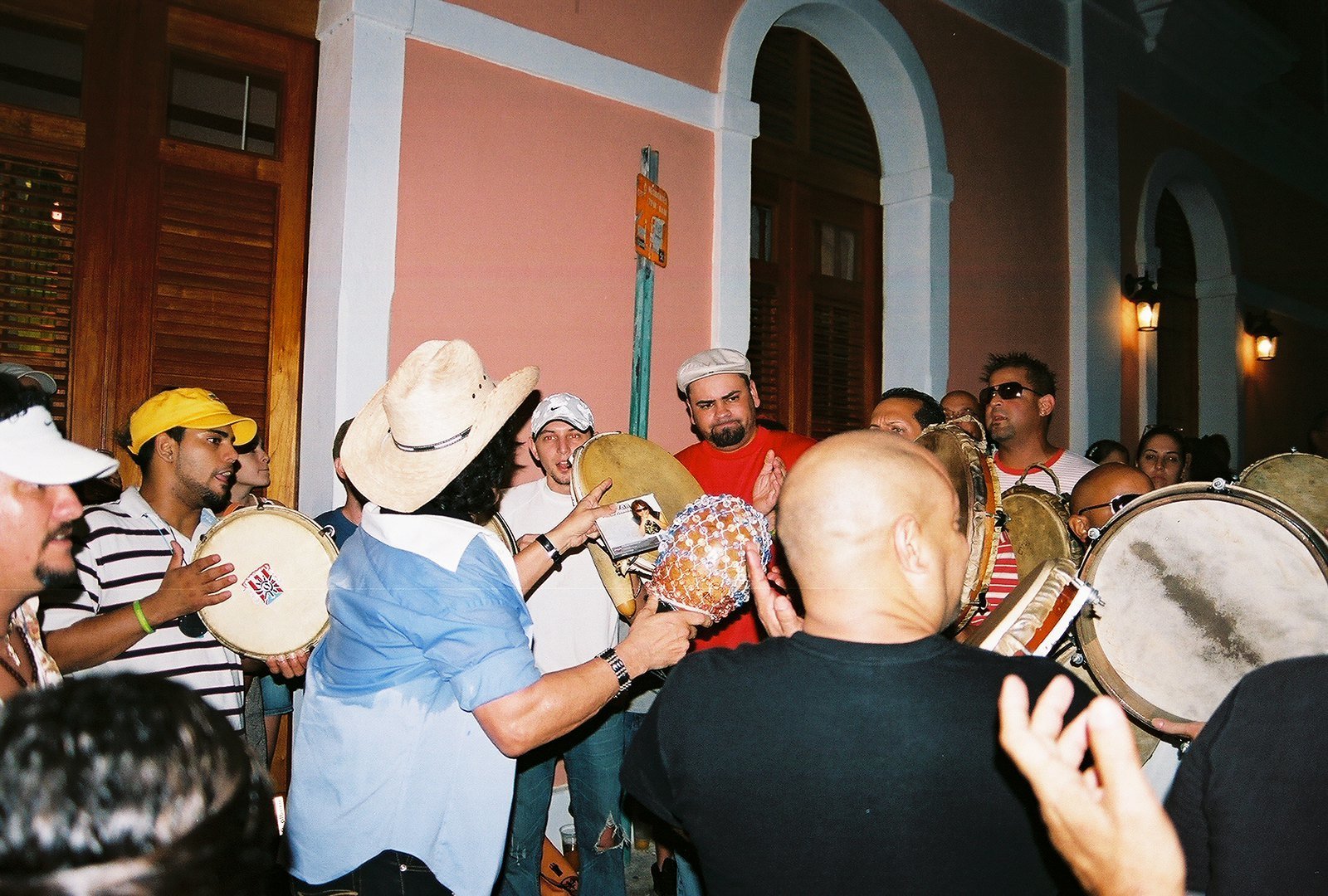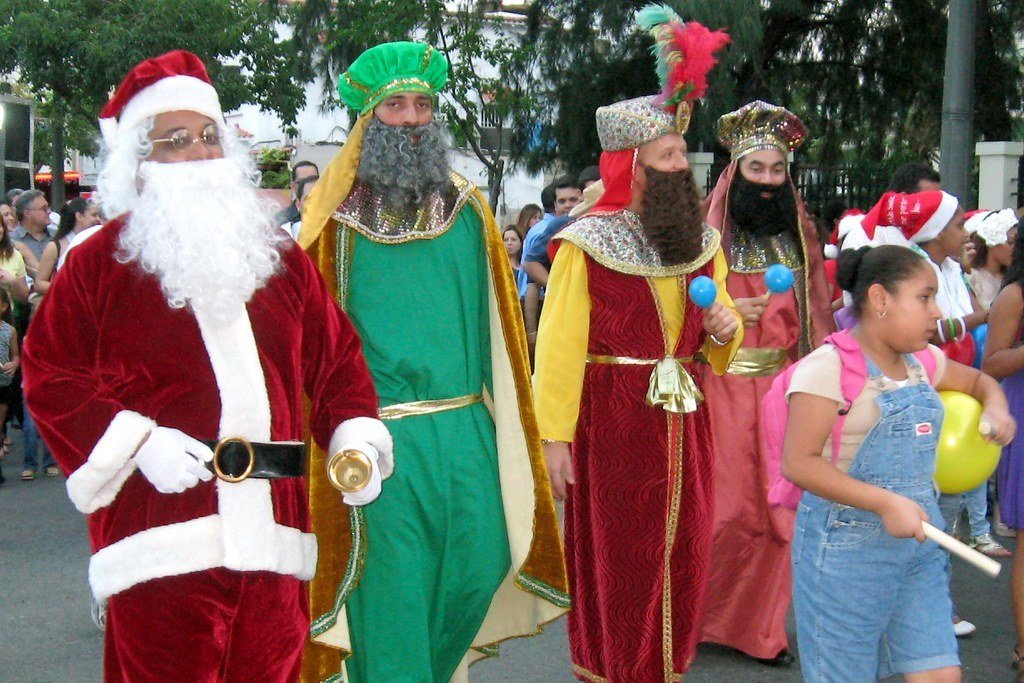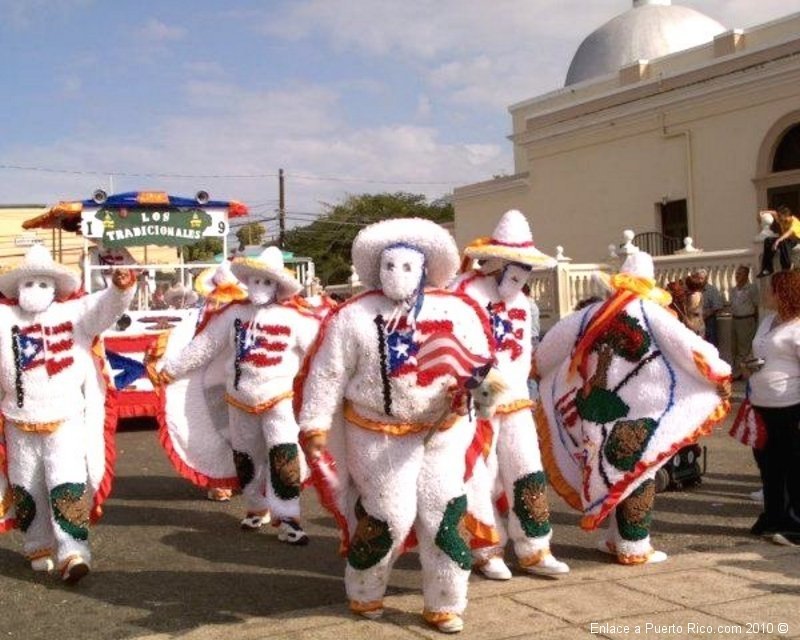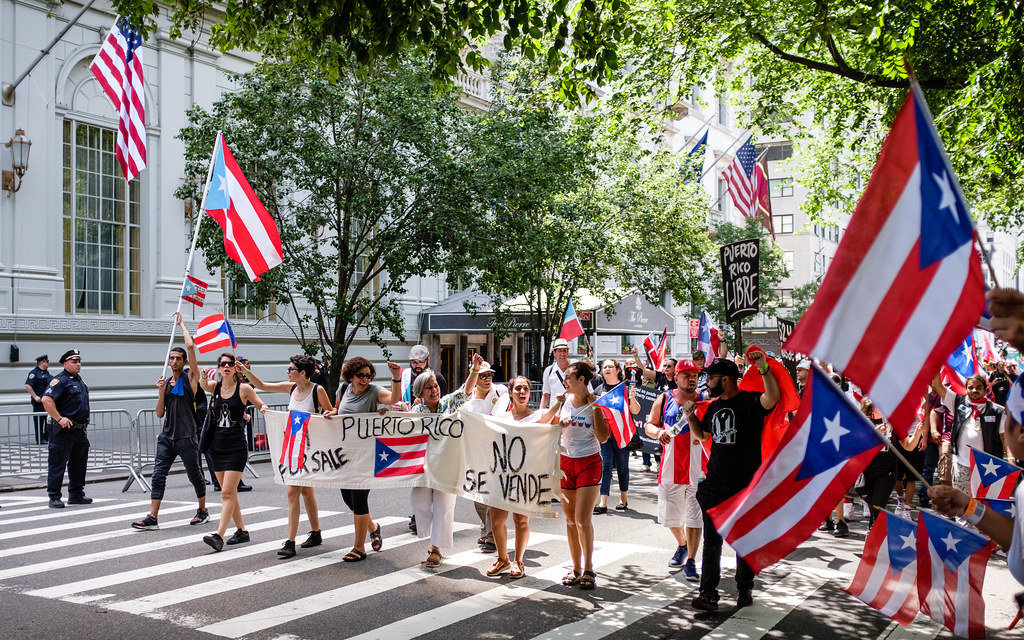
Fiesta Aquí, Fiesta Allá: Music of Puerto Rico
Lesson Hub 1
Introduction to Puerto Rican Music and Dance
3rd grade–5th grade

Sea of Flags (Street View), mural by Gamaliel Ramirez, photo by Jason Morris.
The "Sea of Flags" is a street mural created in 2004 by Gamaliel Ramirez. The mural, located in Chicago’s Humboldt Park neighborhood, depicts Fiesta Boricua: De Bandera a Bandera, an annual 3-day music and cultural festival held in this Chicago neighborhood. In 2018 the Fiesta Boricua celebrated its 25th anniversary and offered 3 stages for the performance of Puerto Rican salsa, reggaeton, bomba, plena, and more.
Fiesta Aquí, Fiesta Allá
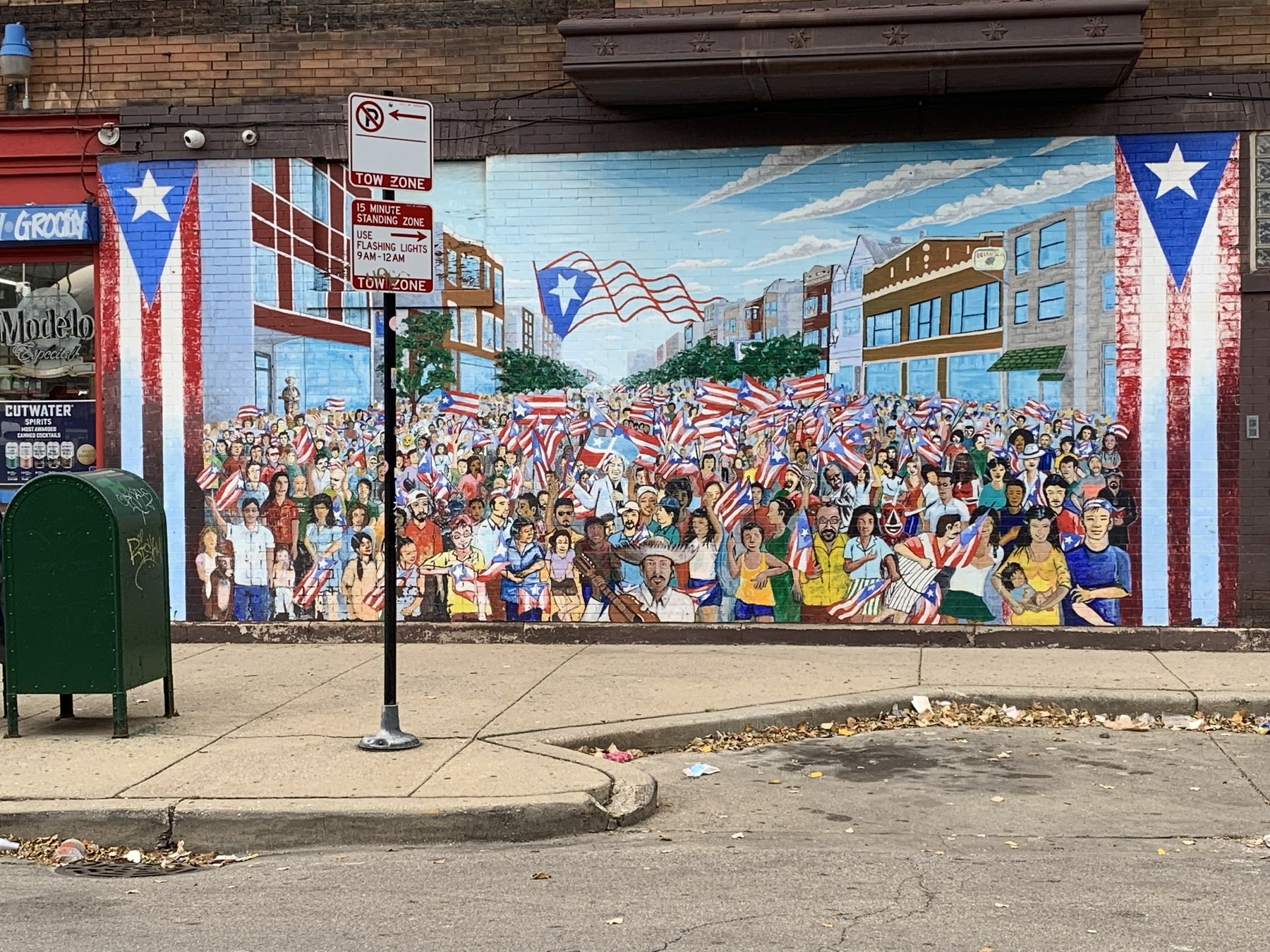

What do Puerto Rican fiestas have to do with Puerto Rican music?
Introduction to Puerto Rican Music and Dance
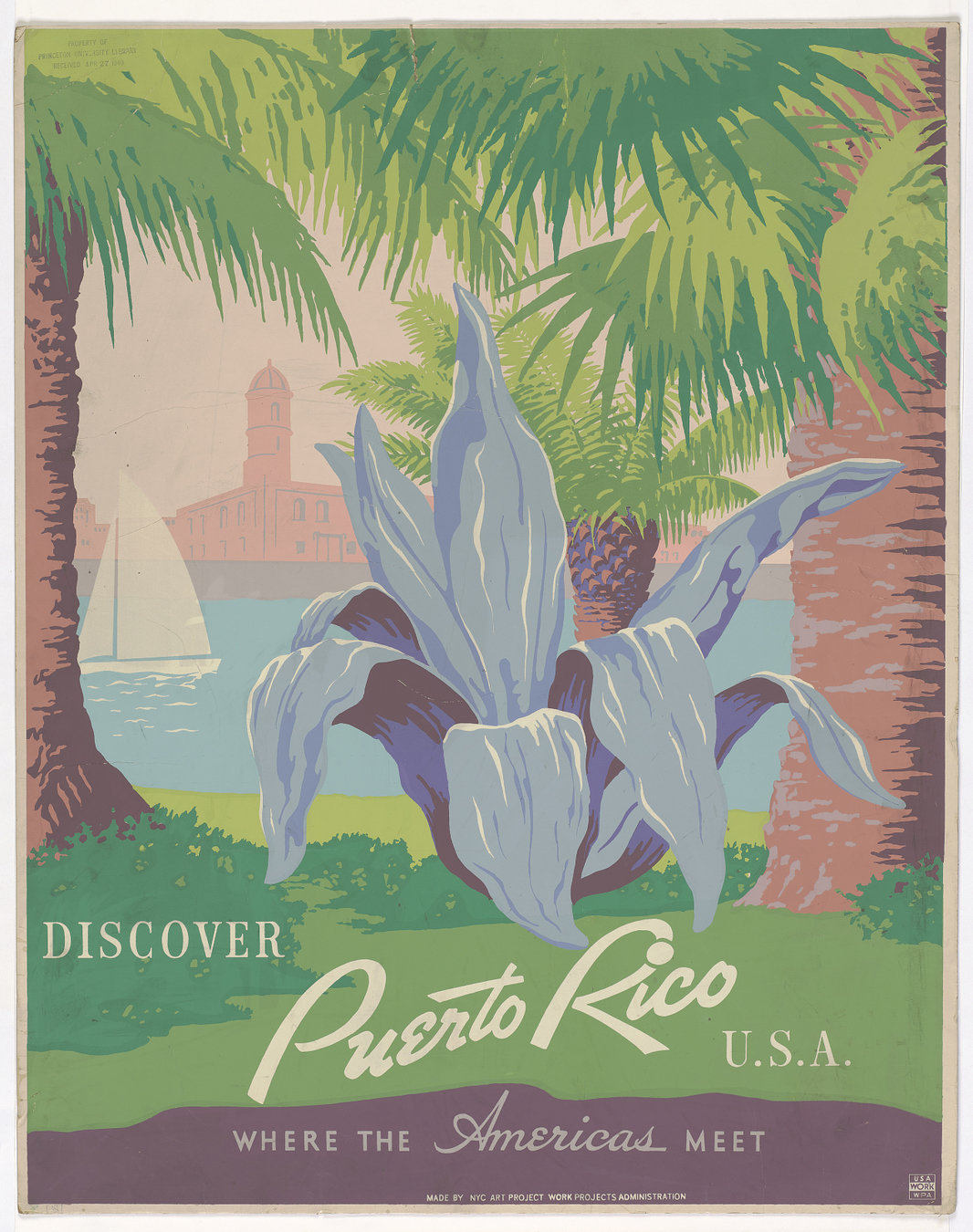
Discover Puerto Rico U.S.A. Where the Americas Meet, by Frank S. Nicholson. Library of Congress.
by Jaíme O. Bofill Calero

Lesson Hub 1: Fiesta Aquí, Fiesta Allá! Introduction to Puerto Rican Music and Dance
CREATIVE CONNECTIONS
HISTORY & CULTURE
MUSIC LISTENING
20+ MIN
20+ MIN
20+ MIN

Fiesta in Puerto Rico!
Path 1

20+ minutes

Rashelle Burns Dances at the Community Batey in La Perla, Puerto Rico, by Mariana Núñez Lozada. Smithsonian Folklife Magazine.

Meet Ana, Your Coquí Frog Guide:
Hello! I’m Ana, the coquí!
As you progress through this Pathway, I'll pop up from time to time to help you learn about some exciting music traditions that come from Puerto Rico!


What sound does a coquí make?
Which of these sounds do you think I make?
1
2
3


Did you know?
I get my name from the sound I make at nighttime!
I have special toe pads that allow me to climb trees and cling to leaves.
Coquí frogs are native to Puerto Rico!

Where is Puerto Rico?


The Caribbean (Political), by U.S. Central Intelligence Agency. University of Texas Libraries.
Puerto Rico is an island in the Caribbean Sea. It is located approximately 1000 miles from Miami, FL.
The Island of Puerto Rico

Map of Puerto Rico, courtesy of freeworldmaps.net
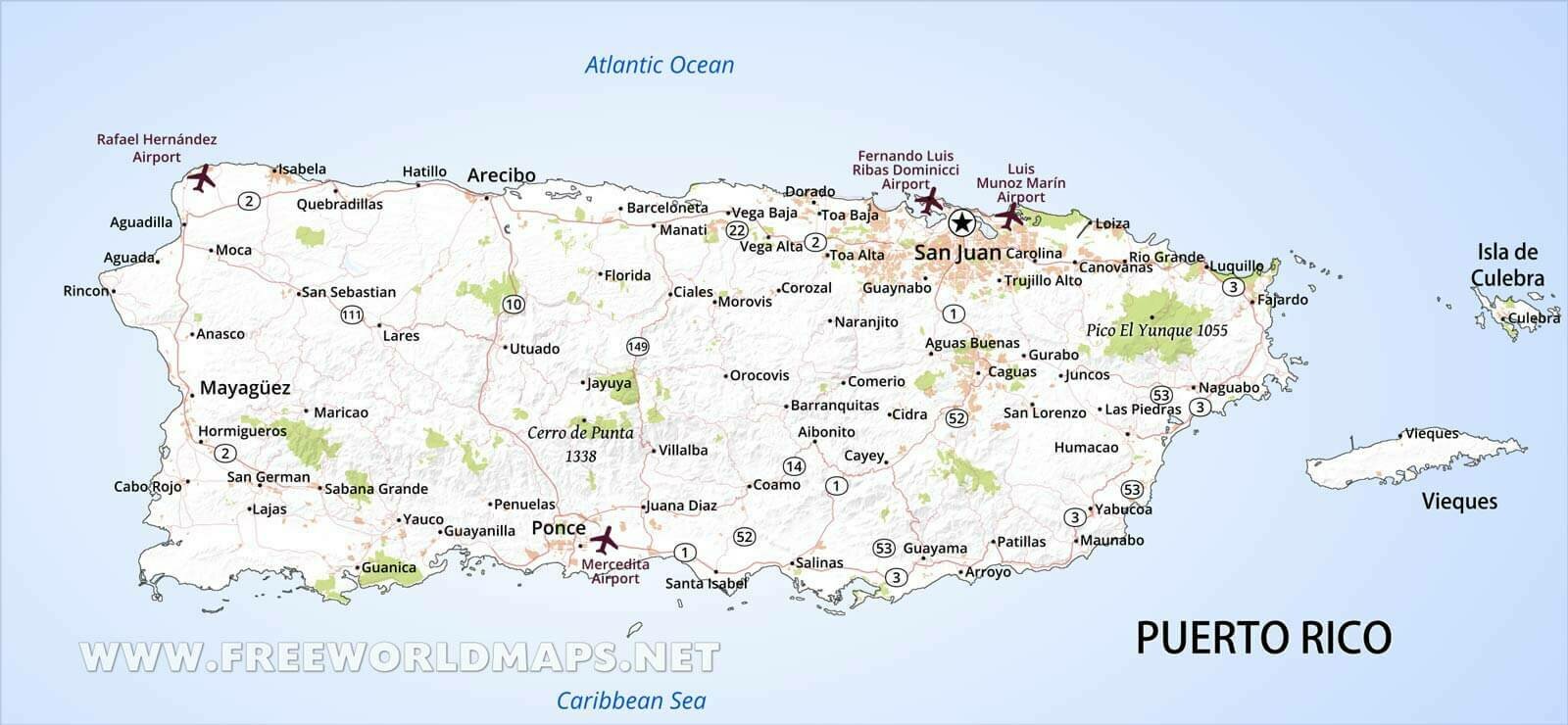
What Is a Fiesta?
In Puerto Rico, a fiesta is a social gathering that can be associated with several things ...


Fiestas in Puerto Rico: Why? (why not?)

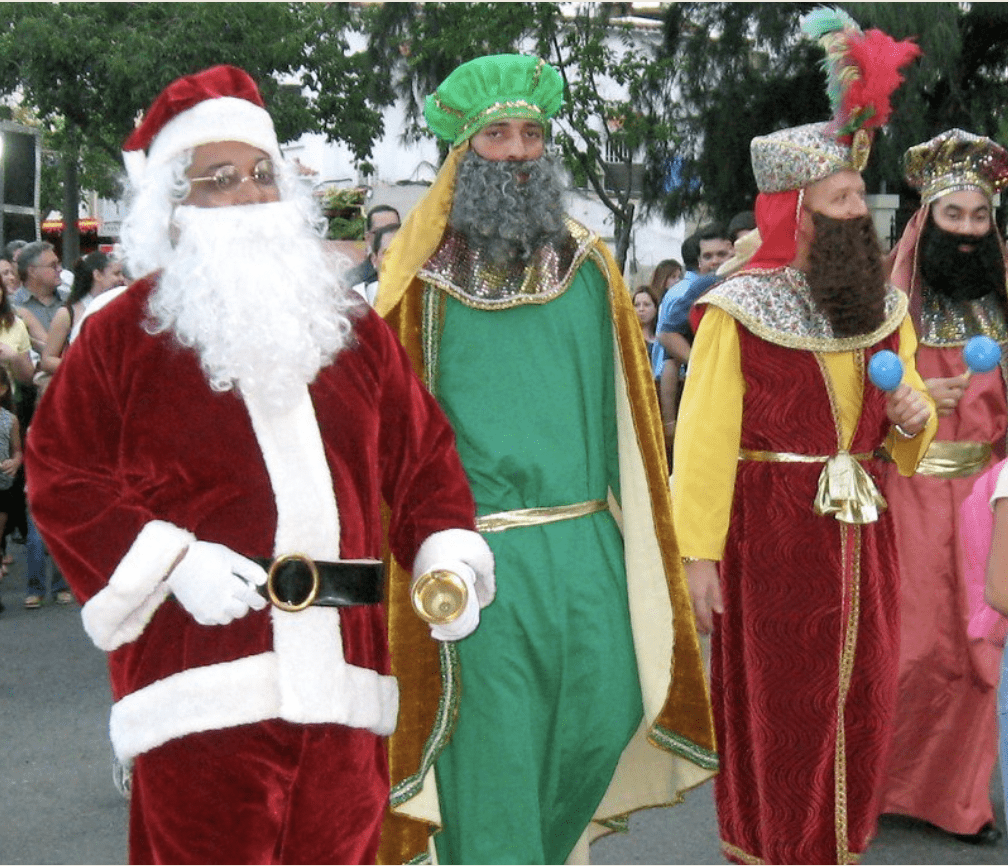
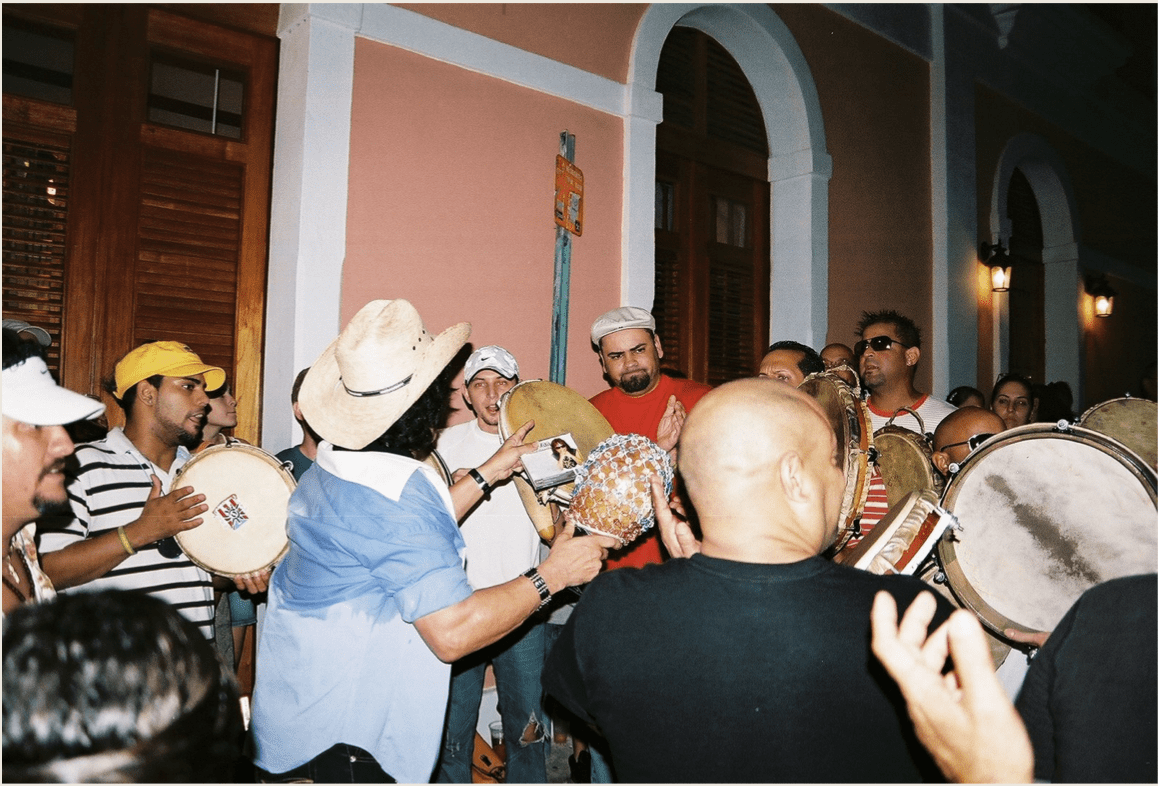

1
2
3
Fiestas in Puerto Rico: When?

In Puerto Rico, the next fiesta is always just around the corner!
Fiestas are celebrated year-round.

Left: Carnival Mask, by Miguel Ángel Caraballo. National Museum of American History. Right: Leatherback Sea Turtle/Tinglar, photo by Claudia Lombard, U.S. Fish and Wildlife Services. CC BY 2.0, via Flickr.
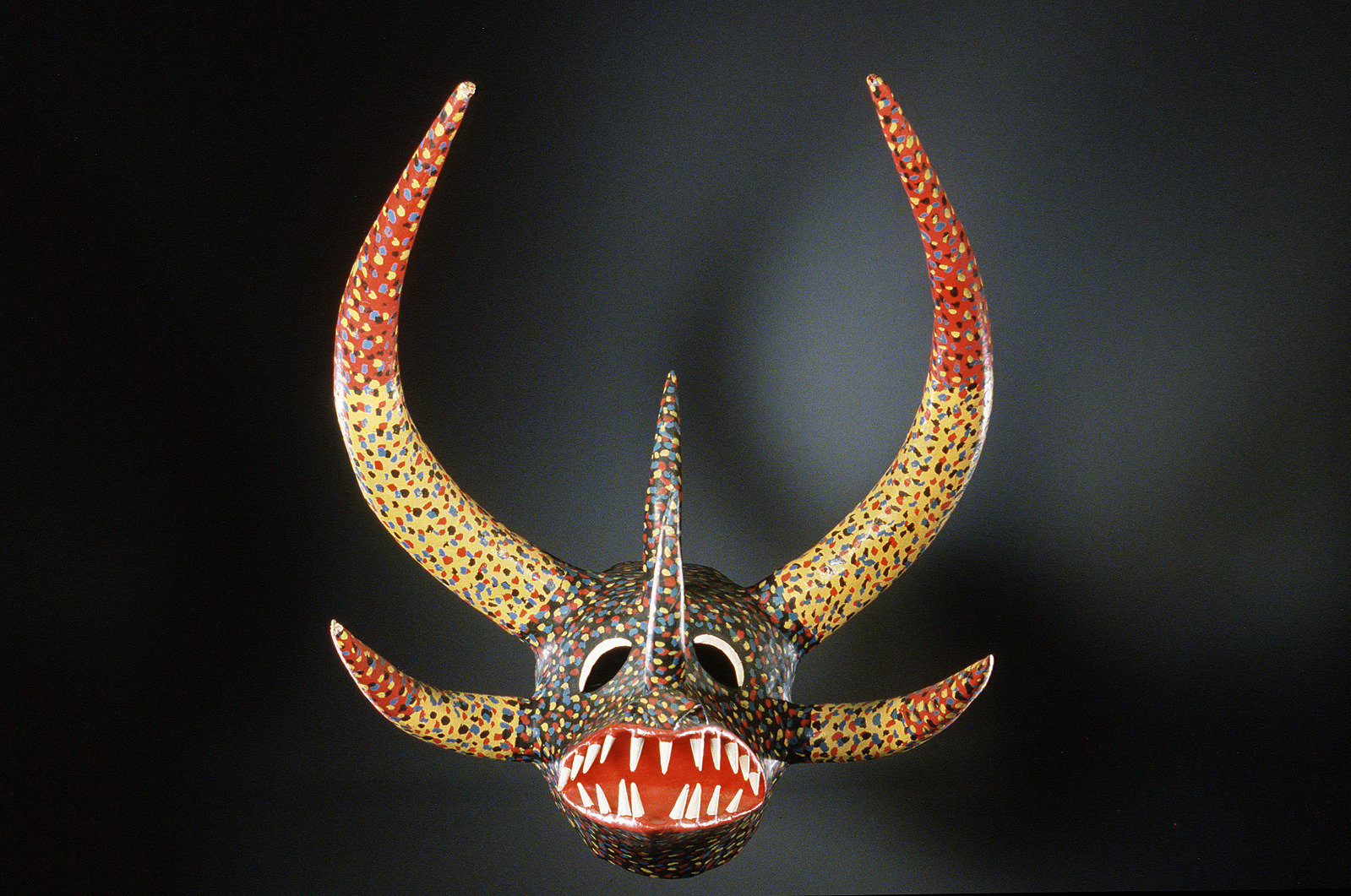
People have been celebrating the Ponce Carnaval for over 250 years.
The Festival del Tinglar (Sea Turtle Festival) began in 2006.
Tradition:
Innovation:
Fiestas in Puerto Rico: Music, Dance, and Food!
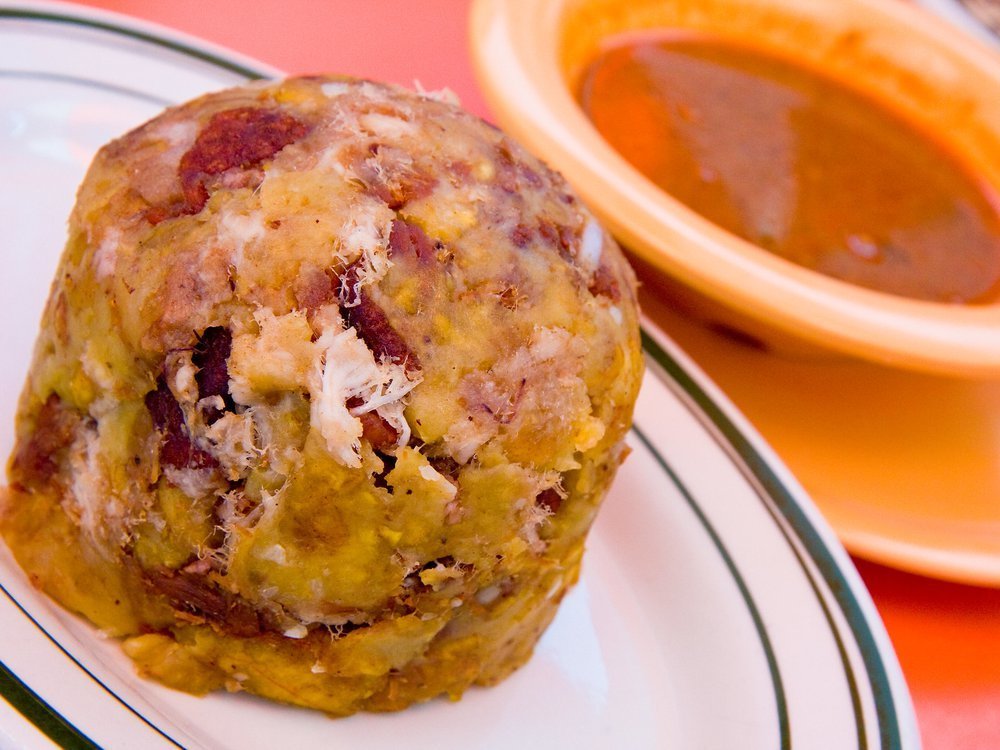

Above: Mofongo with Shredded Pork and Pork Cracklings, Ramonita's, by Garrett Ziegler. CC BY-NC-ND 2.0, via Flickr.


Above: Resurrection City: Untitled, Photograph of a Woman Playing a Guitar and Singing, photo by Jill Freedman. National Museum of African American History and Culture.
Fiestas in Puerto Rican History: The Taíno
The Taíno are indigenous peoples whose ancestors lived on different islands of the Caribbean long before Columbus arrived.
- They call the island Borínquen.
- They are likely to have been the first people to celebrate "fiestas" on the island.
- Spanish historians called their celebrations areytos.

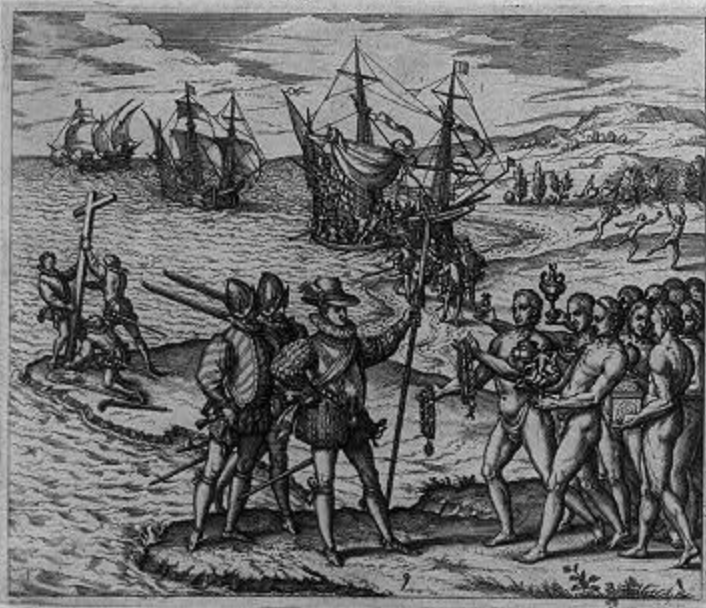
Columbus Landing on Hispaniola, Dec. 6, 1492; Greeted by Arawak Indians, by Theodor de Bry. Library of Congress.
Fiestas in Puerto Rican History: The Batey
Fun fact: The term batey is still used in Puerto Rico and throughout the Caribbean.
People in the community gather there to play music and dance.
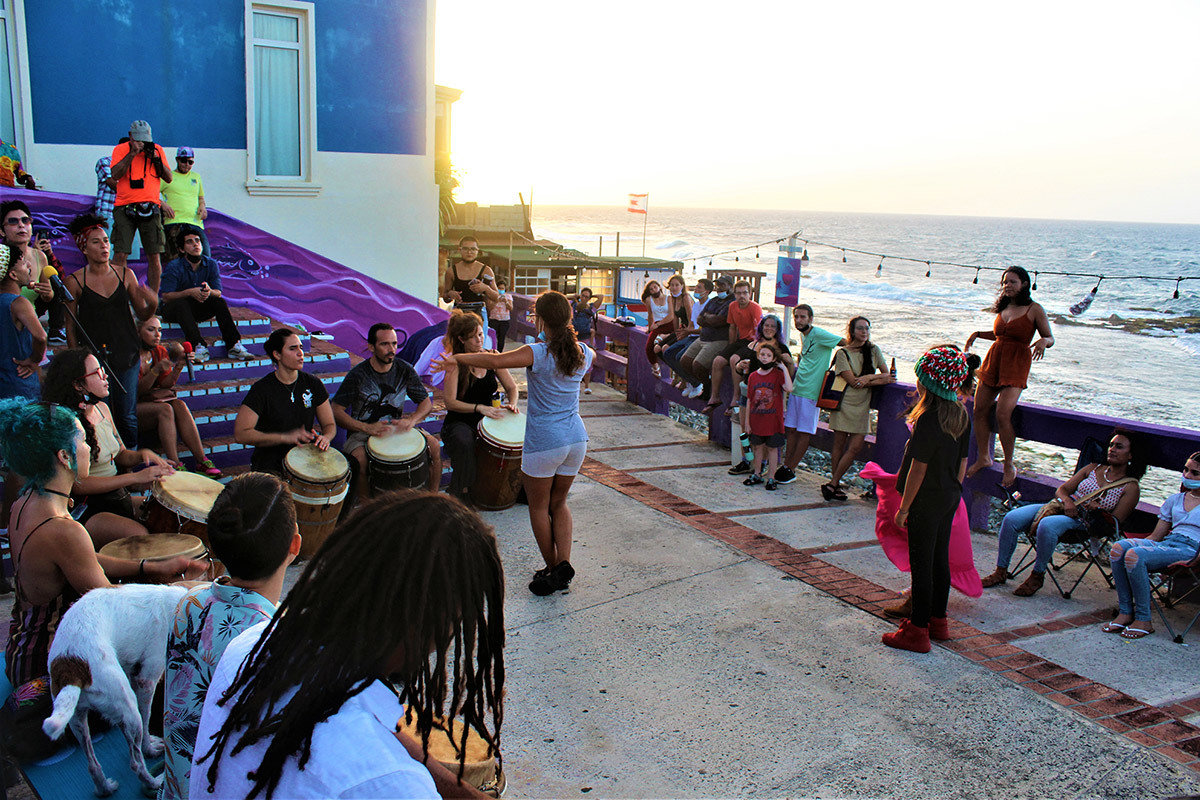
Children Wait Their Turn to Dance in the Community Batey, photo by Mariana Núñez Lozada. Smithsonian Folklife Magazine.

Areytos took place in the batey: A public space at the center of a village.
Listen to "Fiesta en el Batey" ...


El Alma de Puerto Rico: Jíbaro Tradition by Ecos de Borínquen, cover art by Galen Lawson. Smithsonian Folkways Recordings.
This song is an example of música jíbara (a type of Puerto Rican folk music).
Does it sound like music for a fiesta?
Learn all about música jíbara in Lessons 2 and 3!

Colonization in Puerto Rico
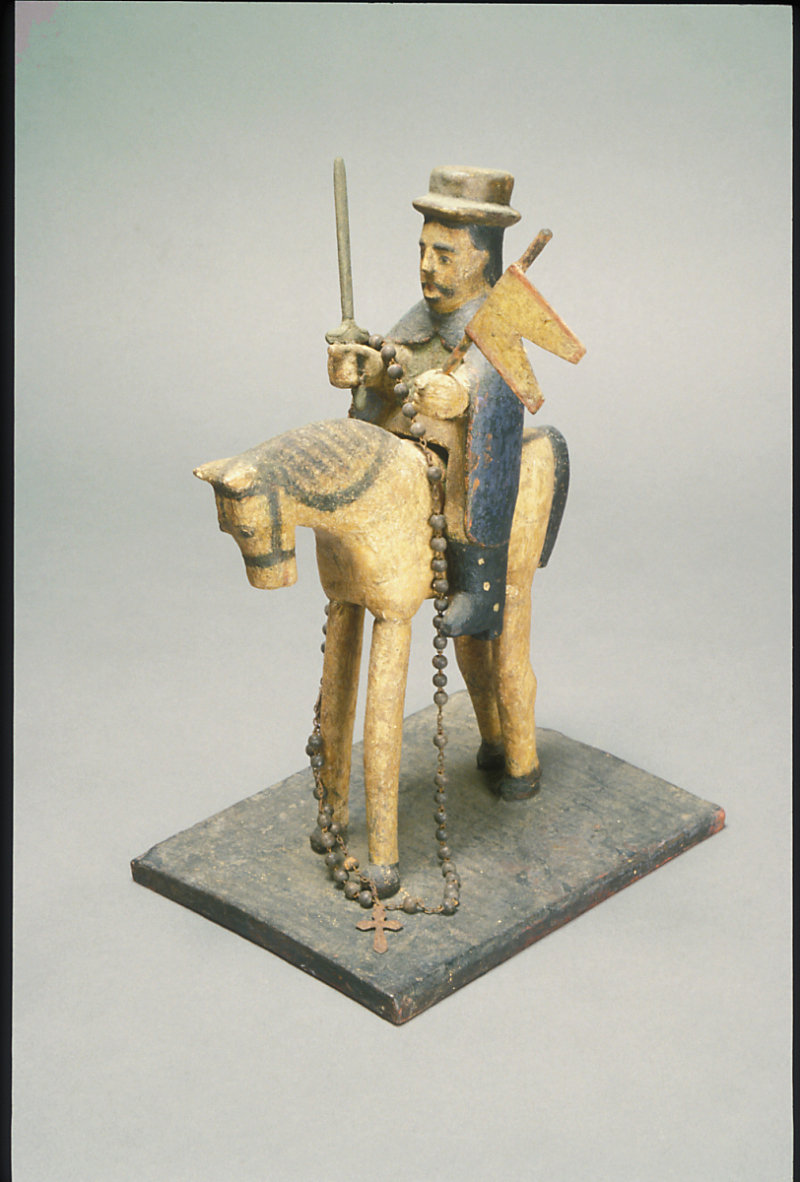

The Spanish colonization of the Americas brought many changes to Puerto Rico, among them:
The image features Saint James the Moor Slayer (Santiago Apóstol), Spain's patron saint and a symbol of the Spanish conquest of the Americas.
Santiago Matamoros, by Pepe, Justina, Jose, and Justina Torres de Ramos. National Museum of American History.
- The Spanish language
- The Catholic religion and related symbols (such as churches) traditions, and celebrations
- A variety of music styles and new instruments
- Enslaved people from other places, like Africa.
The Catholic Church introduced many Spanish religious customs and traditions to Puerto Rico.
Santos from Puerto Rico, unknown artist. Cooper Hewitt, Smithsonian Design Museum.
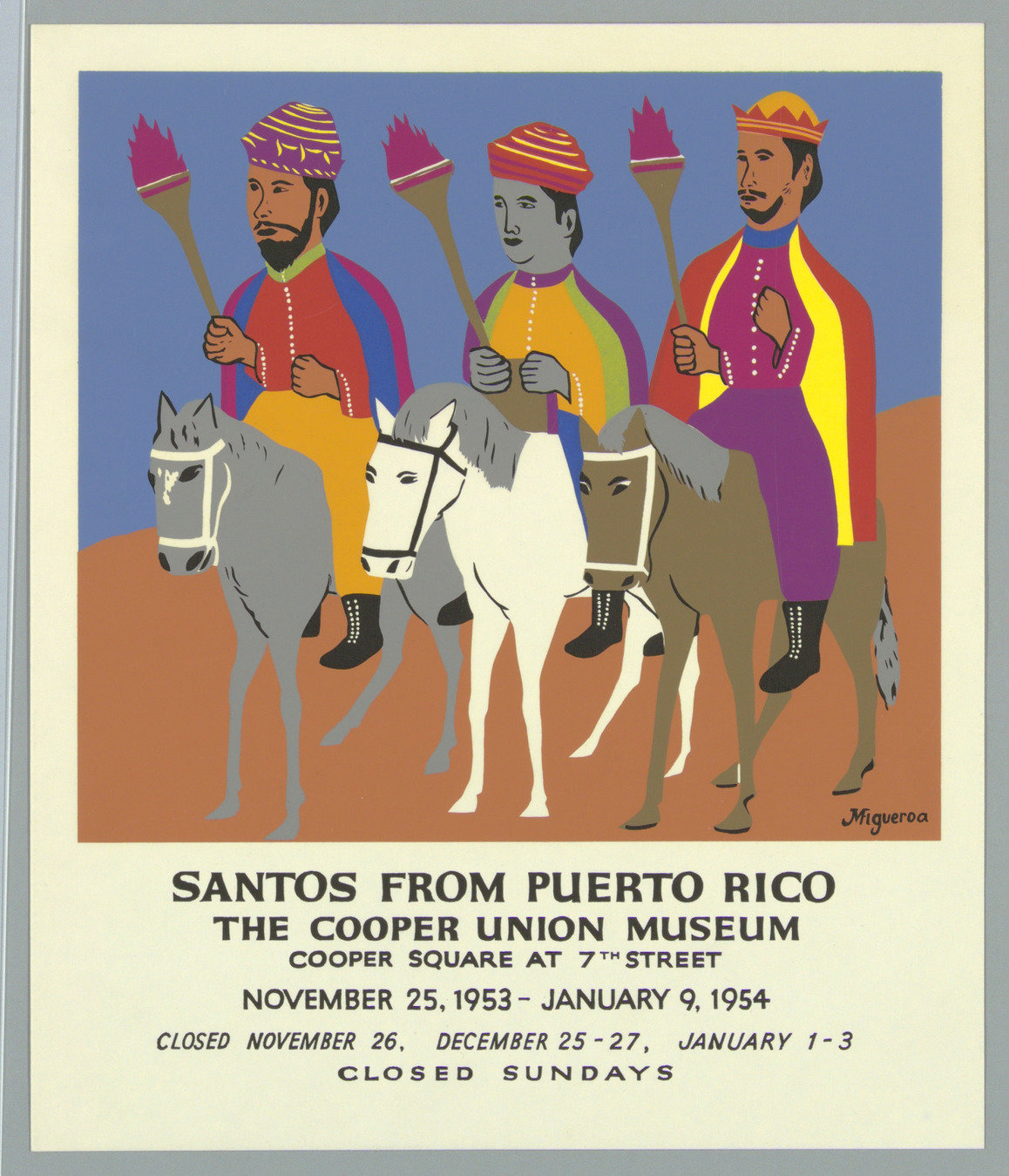

Religious Fiestas
Two important religious fiestas in Puerto Rico are Christmas and Three Kings Day (Epiphany).
Did you know? Every town in Puerto Rico has a church in its central plaza.

Fiesta as Religious Ritual

This video features the Catholic celebration of Fiesta de Reyes (Three Kings Day).
What do you notice about the music?
What do notice about the environment?
Promesa Papo Capí y Maelo Vázquez, video by Jaime O. Bofill Calero.
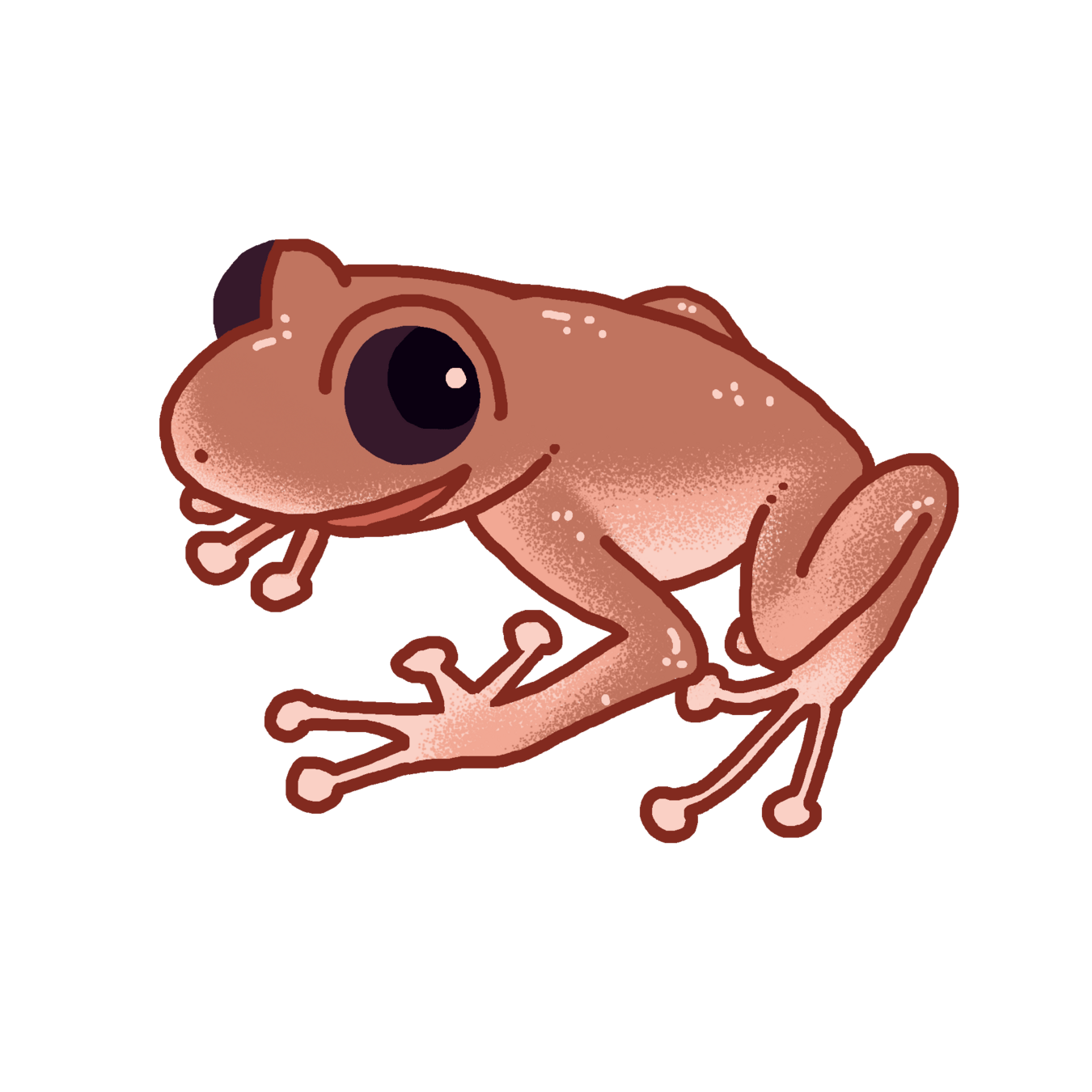
Some Puerto Rican fiestas have nothing to do with religion. These are often called festivals.

Secular Fiestas / Festivals
- They often takes place in public spaces (on a stage) and have larger crowds.
- There is a clear difference between performers and audience members.
- Festival performances are usually planned out carefully ahead of time.
Some things that are different about festivals are:
Los Pleneros de la 21, by Ginerva Portlock. Smithsonian Center for Folklife and Cultural Heritage.
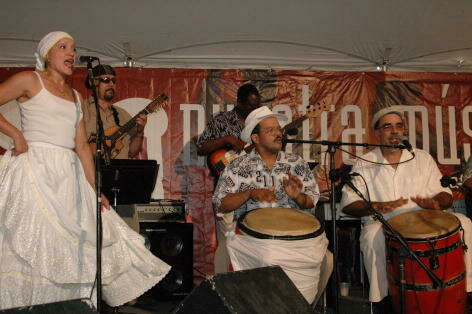
Fiesta as Secular Expression

This video features a Puerto Rican music ensemble performing at a festival.
What do you notice about the music?
What do notice about the environment?
Los Pleneros de la 21 - "El Testigo" [Live at Smithsonian Folklife Festival 2005]. Smithsonian Folkways Recordings.

Puerto Rican Fiestas: Religious AND Secular

Most fiestas in Puerto Rico have a mixture of religious and secular elements.
These traditional fiestas are key in sustaining a collective "Puerto Rican" identity.
What recurring "fiestas" or holidays are celebrated in your culture?
Optional Activity: Review Terms

Challenge Time! Let's see if you can match these terms to their definitions.
secular
doesn't have to do with religion
colonization
música jíbara
a type of Puerto Rican folk music
using power to take control over another area or group of people
Taíno
a public space where people gather to dance and play music
Borinquen
What the Taíno called Puerto Rico
tradition
innovation
a longstanding custom passed from one generation to the next
the introduction of something new
fiesta
batey
coqui
a social gathering or celebration
a little singing tree frog from Puerto Rico
indigenous peoples whose ancestors inhabited Puerto long before the Spanish arrived
Learning Checkpoint
- How would you define the word fiesta and what are three basic elements common to most Puerto Rican fiestas?

- When are fiestas celebrated in Puerto Rico?
- What are some examples of recurring fiestas celebrated in Puerto Rico?
- Why are fiestas important in Puerto Rico?
- What do fiestas have to do with music?
End of Path 1: Where will you go next?


Sounds of Puerto Rican Fiesta
Path 2

20+ minutes

Los Pleneros de la 21, by Ginerva Portlock. Smithsonian Center for Folklife and Cultural Heritage.


A Quick Review: Fiestas in Puerto Rico

In Path 1 we learned that fiestas are an important part of life and culture in Puerto Rico.
Fiestas are celebrated year-round and can be associated with several things: Some are more religious and others are more secular. Some are old and some are new.
In Puerto Rico, the next fiesta is always just around the corner!


Where is Puerto Rico?


The Caribbean (Political), by U.S. Central Intelligence Agency. University of Texas Libraries.
Puerto Rico is an island in the Caribbean Sea. It is located approximately 1000 miles from Miami, FL.

The Importance of Traditional Fiestas
Traditional fiestas are key in sustaining a collective Puerto Rican identity.

Although not all Puerto Ricans are Catholic, many traditional fiestas that are celebrated follow the Catholic liturgical calendar.


Fiestas involve:
- Food!
- Dance!
- Music!
What examples are shown here?



The Sounds of Fiesta!
In Path 2, you will learn more about some of the musical sounds that are associated with fiestas in Puerto Rico.


Attentive Listening #1
Listen to this example of fiesta music.


What musical sounds do you hear?
What type of fiesta do you think this is for?


Bomba!


You just listened to an example of bomba music.
Did you hear:
- Drums?
- Singing?
- Call and Response?
- Sticks?
- Scrapers/shakers?
"Siré y Síre" performed by Viento de Agua


Fiesta Santiago Apóstol de Loíza

You are likely to hear bomba music at the Fiesta Santiago Apóstol.

Carretón Alegre During Procession in Loiza, photo by Lowell Fiet. Digital Library of the Caribbean.
In the coastal town of Loíza, it is celebrated for 10 days, from July 24–August 2.


Loíza, Puerto Rico

Map of Puerto Rico, courtesy of freeworldmaps.net


Attentive Listening #2
Listen to this example of fiesta music.


What musical sounds do you hear?
What type of fiesta do you think this is for?


Plena!

You just listened to an example of plena music.
Did you hear:
- Drums?
- Singing?
- Call and response?
- Interlocking rhythms?
- Driving, percussive beat?
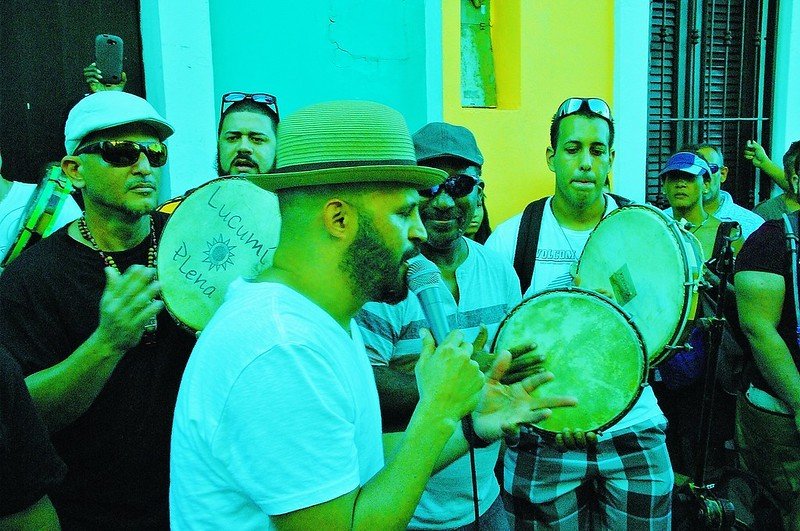
Panderos Drums Trio and Singer, photo by Angel Xavier Viera-Vargas. CC BY-ND 2.0, via Flickr.
"Maringracia," performed by Viento de Agua

Carnaval

Carnaval is celebrated all over the island during the two weeks leading up to Lent.
Vejigante Performers in Front of a Streetlight, unknown photographer. National Museum of American History.

You are likely to hear plena music at Carnaval!
The biggest Carnaval celebration in Puerto Rico takes place in the city of Ponce.


Ponce, Puerto Rico

Map of Puerto Rico, courtesy of freeworldmaps.net


Attentive Listening #3
Listen to this example of fiesta music.


What musical sounds do you hear?
What type of fiesta do you think this is for?


Música Jíbara!

You just listened to an example of música jíbara.
Did you hear:
- String instruments? (guitar and cuatro)
- Two singers?
- Drums? (bongos)
- Güiro?
- Strophic form? (AAA)
"Un sol de esperanza (A Light of Hope)," performed by Ecos de Borinquen

El Alma de Puerto Rico, cover art by Galen Lawson, Smithsonian Folkways Recordings.

Fiesta de la Calle San Sebastian
Fiesta de la Calle San Sebastian, celebrated around January 20th, draws thousands of people each year to the streets of Old San Juan.

You are likely to hear an aguinaldo (a type of música jíbara) at the Fiesta de la Calle San Sebastian in San Juan.

Old San Juan Puerto Rico Fiestas De La Calle San Sebastian, ID 235400585. © Edgardo Cuevas|Dreamstime.com.
Associcated with a huge artisan fair, it is the unofficial closing to the longest Christmas season in the world.

San Juan, Puerto Rico

Map of Puerto Rico, courtesy of freeworldmaps.net


Optional Activity: Compare and Contrast

Bomba
Instruments?
Structure?
Rhythm/beat?
Pitch/melody?
Música jíbara
Plena
Instruments?
Structure?
Rhythm/beat?
Pitch/melody?
Instruments?
Structure?
Rhythm/beat?
Pitch/melody?

Blending Cultural Practices

Puerto Rican Fiesta Music
Indigenous
Spanish
African


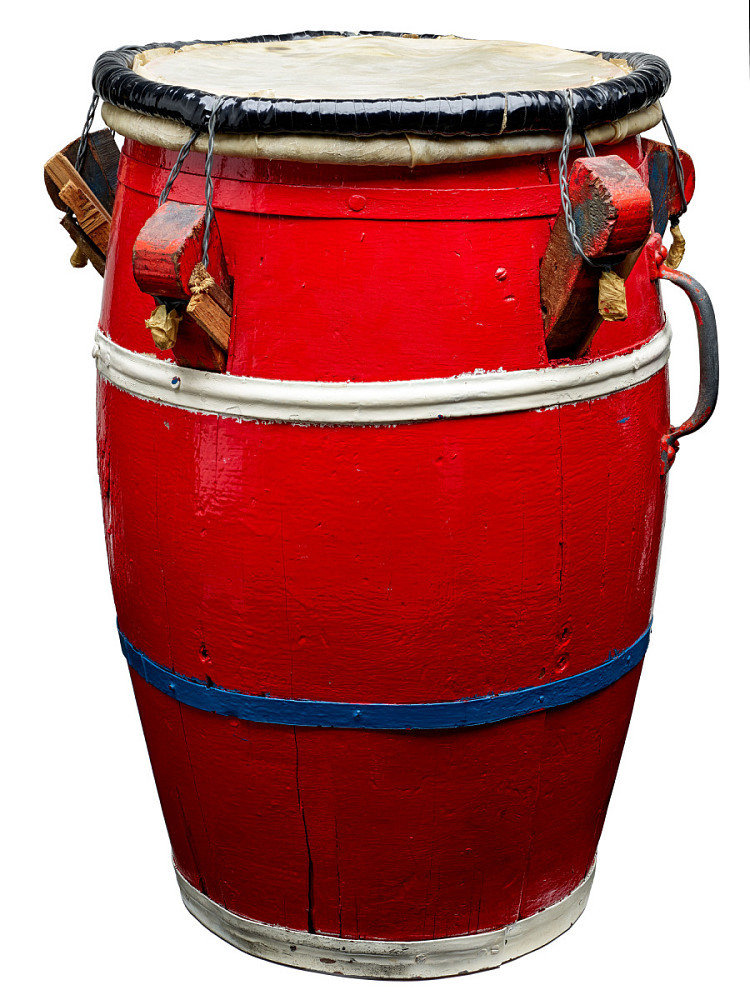
Bomba Drum, unknown maker. National Museum of American History.
Güiro, unknown maker. National Museum of American History.

Learning Checkpoint
-
What three distinct cultural influences are present in Puerto Rican fiesta music?

-
What are three uniquely Puerto Rican musical genres that you might hear at a fiesta or festival?
End of Path 2: Where will you go next?




Puerto Rican Fiesta and Identity
Path 3

20+ minutes

Girl Dancing Bomba at Fiesta de Santiago Apostol, photo by Lowell Fiet. Digital Library of the Caribbean.

A Quick Review: Fiestas in Puerto Rico

In Path 1, we learned that fiestas in Puerto Rico are an important part of life - they bring communities together.
In Path 2, we learned that Puerto Rican fiestas and related music traditions often mix elements from Indigenous (i.e., Taíno), African, and European (i.e., Spanish) cultures.
Fiestas often involve three main elements: music, dance, and food.


Where is Puerto Rico?


The Caribbean (Political), by U.S. Central Intelligence Agency. University of Texas Libraries.
Puerto Rico is an island in the Caribbean Sea. It is located approximately 1000 miles from Miami, FL.


Fiestas and Identity
In Path 3, we will consider how fiestas provide people with opportunities to express different aspects of their collective, Puerto Rican identities.


What is Identity?


Personal identity is what makes you, well ... you!
Collective identity is your sense of belonging to a group.
A few more things to remember:
- Everyone has multiple collective (group) identities.
- Collective identities can affect your personal identity.
- Your identity can evolve and change over time.



Local, national, and even international fiestas bring people together to share and celebrate traditions (old and new) and discover and express their collective "Puerto Rican" identities.
Let's take a look at some examples.

Fiesta Aquí, Fiesta Allá!



Cultural Identity

The unique fusion of beliefs, traditions, and practices is central to Puerto Rican cultural identity.
Cultural fusion is on full display at fiestas of all sizes, expressed through music, dance, costumes, food, etc...
1
2
3


Regional Identity

Arguably the most well-known fiesta in the world, Carnaval promotes a regional, cultural identity with other countries in the Caribbean region and South America.


Local / Community Identity

Smaller, more informal (and sometimes spontaneous) fiestas are the lifeblood of local communities.
Music and dance play a central role in these events.
Plenazo 3, photo by Angel Xavier Viera-Vargas. CC BY-NC-ND 2.0, via Flickr.
Dancer and Musicians at the Community Batey of la Plaza del Negro, photo by Mariana Núñez Lozada. Smithsonian Folklife Magazine.

Religious Identity

Not all Puerto Ricans are Catholic, but many fiestas in Puerto Rico are derived from the Catholic liturgical calendar.
Most of these fiestas blend religious and secular elements.
Christmas and Three Kings Day are good examples.
Christmas Parade in Condado, Puerto Rico, by Alan Kotok. CC BY 2.0, via Flickr.



National / Patriotic Identity

Sometimes, people gather together to display and celebrate their national pride.

Mascaras de Hatillo, Puerto Rico, photo by Joe Delgado. CC BY-SA 2.0, via Flickr.


Puerto Rican "National Identity"

In Puerto Rico, national identity is a complicated issue.


Flag of Puerto Rico, by Cerejota and Sarang. CC-PD-Mark, via Wikimedia Commons.
Flag of the United States, by Dbenbenn, Technion, and Steinsplitter. CC-PD-Mark, via Wikimedia Commons.
Officially, Puerto Rico is an unincorporated territory of the United States.
What does that mean?


Political Identity

In Puerto Rico, national identity is a complicated issue that is also tied to political identity.
Puerto Rico No Se Vende, photo by ep_jhu. CC BY-NC 2.0, via Flickr.
- Some people want the current arrangement to continue (Estado Libre Asociado / Commonwealth).
- Some people want Puerto Rico to become its own independent nation.
- Others favor U.S. statehood (so Puerto Ricans can have all the same rights as other U.S. citizens).

Diasporic Identity

Did you know? Today, almost 6 million people of Puerto Rican descent live in the rest of the United States.
They are part of the Puerto Rican Diaspora.


Diasporic Identity

There are many fiestas / festivals in the United States that celebrate Puerto Rican heritage.
The Puerto Rican Festival of Massachusetts 2017, unknown photographer. Courtesy of Puerto Rican Festival of MA.
Puerto Rican Parade, New York City, 1987 (Tito Puente, Grand Marshal), unknown photographer. National Museum of American History.
Fiestas link communities!
Generally Speaking .....
Creative Activity

Let's return to the identity bubbles you completed earlier.
Can you think of any "fiestas" (celebrations or social gatherings) that support your sense of belonging to each group (collective identity)?


Learning Checkpoint

-
What is collective identity?
-
What are some key aspects of Puerto Rican identity?
-
How do fiestas (and music) help people discover, celebrate, and express their Puerto Rican identities?
End of Path 3 and Lesson Hub 1: Where will you go next?


Continue to Lesson Hub 2:
Música Jíbara, Seis, and Concurso




Lesson 1 Media Credits

Audio courtesy of
Smithsonian Folkways Recordings
Video courtesy of
Smithsonian Folkways Recordings
Jaime Bofill
Images courtesy of
Smithsonian American Art Museum
Learning for Justice
Smithsonian Folkways Recordings
Smithsonian Center for Folklife and Cultural Heritage
National Museum of African American History and Culture
National Museum of American History
Puerto Rican Festival of MA
Smithsonian Folklife Magazine
University of Texas at Austin, PCLP Map Collection
Lowell Fiet, Digital Library of the Caribbean
Cooper Hewitt, Smithsonian Design Museum
Library of Congress
Freeworldmaps.net

© 2022 Smithsonian Institution. Personal, educational, and non-commercial uses allowed; commercial rights reserved. See Smithsonian terms of use for more information.
This Pathway received federal support from the Latino Initiatives Pool, administered by the Smithsonian Latino Center.
For full bibliography and media credits, see Lesson 1 landing page.






